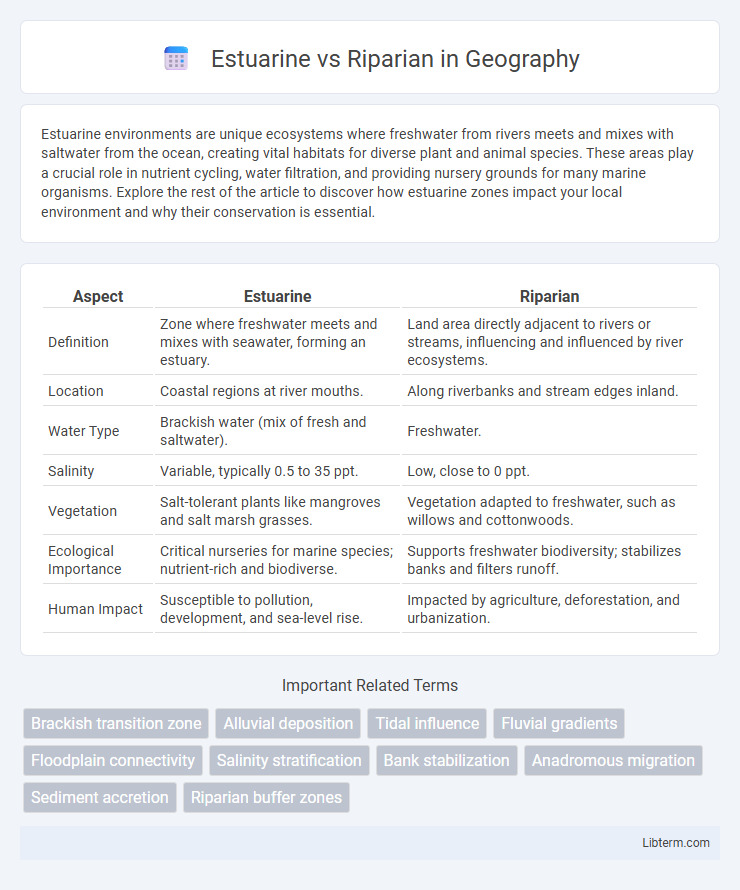Estuarine environments are unique ecosystems where freshwater from rivers meets and mixes with saltwater from the ocean, creating vital habitats for diverse plant and animal species. These areas play a crucial role in nutrient cycling, water filtration, and providing nursery grounds for many marine organisms. Explore the rest of the article to discover how estuarine zones impact your local environment and why their conservation is essential.
Table of Comparison
| Aspect | Estuarine | Riparian |
|---|---|---|
| Definition | Zone where freshwater meets and mixes with seawater, forming an estuary. | Land area directly adjacent to rivers or streams, influencing and influenced by river ecosystems. |
| Location | Coastal regions at river mouths. | Along riverbanks and stream edges inland. |
| Water Type | Brackish water (mix of fresh and saltwater). | Freshwater. |
| Salinity | Variable, typically 0.5 to 35 ppt. | Low, close to 0 ppt. |
| Vegetation | Salt-tolerant plants like mangroves and salt marsh grasses. | Vegetation adapted to freshwater, such as willows and cottonwoods. |
| Ecological Importance | Critical nurseries for marine species; nutrient-rich and biodiverse. | Supports freshwater biodiversity; stabilizes banks and filters runoff. |
| Human Impact | Susceptible to pollution, development, and sea-level rise. | Impacted by agriculture, deforestation, and urbanization. |
Introduction to Estuarine and Riparian Systems
Estuarine systems are dynamic environments where freshwater from rivers meets and mixes with saltwater from the sea, creating unique brackish habitats rich in biodiversity. Riparian systems refer to the interface between land and freshwater bodies such as rivers, streams, and lakes, serving as crucial zones for nutrient cycling and supporting diverse terrestrial and aquatic species. Both systems play vital roles in ecosystem functions, including water filtration, habitat provision, and maintaining ecological connectivity.
Defining Estuarine Environments
Estuarine environments are coastal areas where freshwater from rivers meets and mixes with saltwater from the ocean, creating unique brackish water habitats rich in nutrients and biodiversity. These zones support diverse ecosystems, including tidal wetlands, mudflats, and salt marshes, which serve as critical breeding and feeding grounds for numerous aquatic species. Estuaries function as natural filters, trapping pollutants and sediments, while also buffering coastal areas against storm surges and erosion.
Understanding Riparian Zones
Riparian zones are transitional areas between terrestrial and aquatic ecosystems, characterized by distinct vegetation and soil types that influence water quality and habitat stability. These zones play a critical role in filtering pollutants, reducing erosion, and providing biodiversity hotspots along riverbanks and streams. Understanding riparian zones involves studying their hydrology, plant communities, and interactions with adjacent upland and aquatic environments to effectively manage and restore freshwater ecosystems.
Key Differences Between Estuarine and Riparian Areas
Estuarine areas are coastal zones where freshwater from rivers meets and mixes with saltwater from the ocean, creating brackish water environments rich in biodiversity and nutrient cycling. Riparian areas are the interface between land and a river or stream, characterized by freshwater ecosystems that support diverse plant and animal species while stabilizing banks and filtering pollutants. Key differences include salinity levels, with estuarine environments being brackish and influenced by tides, while riparian zones are strictly freshwater and primarily shaped by river flow dynamics.
Ecological Functions of Estuarine Habitats
Estuarine habitats play a critical role in nutrient cycling, serving as nutrient-rich transition zones where freshwater mixes with saltwater, supporting diverse aquatic species and promoting high primary productivity. These areas act as natural filters, trapping sediments, pollutants, and excess nutrients, thereby improving water quality and protecting coastal ecosystems. Estuaries also provide essential breeding and nursery grounds for numerous fish and invertebrate species, contributing significantly to biodiversity and fisheries productivity.
Biodiversity in Riparian Ecosystems
Riparian ecosystems support exceptionally high biodiversity due to their unique position as transitional zones between terrestrial and aquatic environments, providing critical habitat for numerous plant and animal species. These areas maintain water quality, stabilize riverbanks, and create corridors that facilitate wildlife movement, thereby enhancing ecological connectivity. Compared to estuarine systems, riparian zones often exhibit greater species richness in both flora and fauna, particularly in freshwater-dependent organisms and terrestrial wildlife.
Hydrological Processes in Estuarine vs Riparian Systems
Estuarine systems experience complex hydrological processes driven by tidal fluctuations, saline water intrusion, and sediment deposition, creating dynamic nutrient exchange and habitat diversity. Riparian systems are primarily influenced by fluvial hydrology, with seasonal river flow variations, groundwater interactions, and floodplain connectivity regulating sediment transport and nutrient cycling. Hydrological connectivity in estuaries supports brackish water ecosystems, while riparian zones maintain freshwater habitats critical for terrestrial-aquatic interface functions.
Human Impacts and Conservation Challenges
Estuarine environments, characterized by the mixing of freshwater and seawater, face human impacts such as pollution from urban runoff, habitat destruction due to coastal development, and overfishing, which disrupts the delicate balance of nutrient cycling and aquatic species. Riparian zones, the interface between land and a river or stream, suffer from agricultural runoff, deforestation, and riverbank erosion, leading to loss of biodiversity and impaired water quality. Conservation challenges for both ecosystems involve mitigating nutrient pollution, restoring native vegetation, and implementing sustainable land-use practices to preserve ecological function and resilience.
Restoration Practices: Estuarine vs Riparian Approaches
Estuarine restoration practices emphasize sediment management and tidal flow restoration to rebuild habitat complexity and improve water quality, while riparian restoration focuses on stabilizing stream banks, re-vegetating native plants, and enhancing shading to reduce water temperature. Estuarine projects often involve breaching dikes or removing barriers to reestablish natural tidal flushing, whereas riparian approaches prioritize controlling erosion and reconnecting floodplains to improve hydrological functions. Both restoration types require monitoring nutrient cycling and biodiversity recovery to ensure ecosystem resilience.
Importance of Protecting Both Habitats
Estuarine and riparian habitats play crucial roles in maintaining biodiversity, water quality, and ecosystem stability. Protecting estuarine areas ensures the preservation of vital nursery grounds for fish and buffers against storm surges, while safeguarding riparian zones supports soil erosion control and provides essential corridors for terrestrial wildlife. Conservation efforts targeting both habitats enhance ecological resilience and promote sustainable water resource management.
Estuarine Infographic

 libterm.com
libterm.com